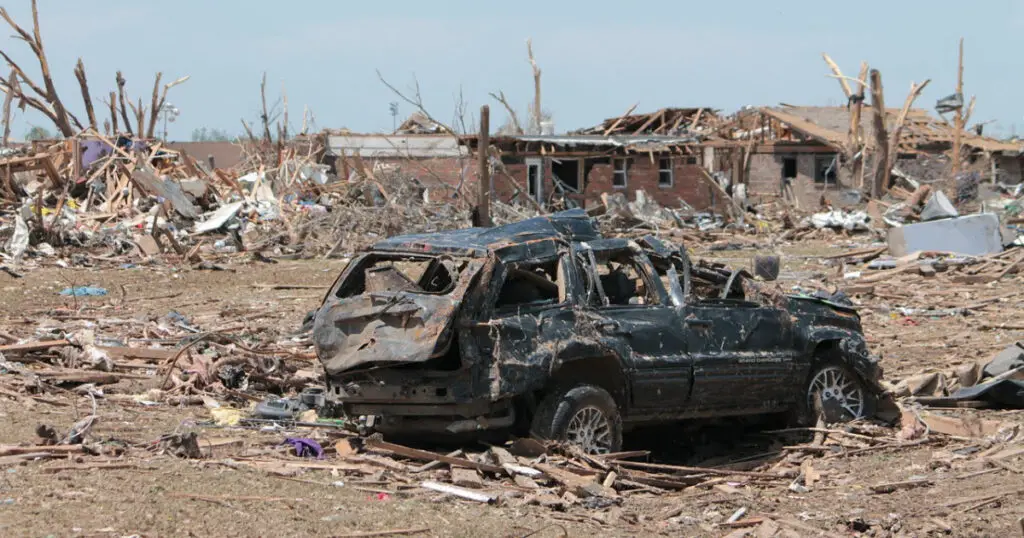Tornadoes are violent columns of rotating winds that come into contact with the Earth’s surface. A powerful natural weather phenomenon, each tornado is so unpredictable and erratic that it’s difficult to know exactly how a given tornado will behave. But data has helped meteorologists make some interesting findings. This article is about how tornadoes travel on the ground. We’ll touch briefly on how tornadoes form and how weather conditions push these storms to travel at different speeds and in different directions. At the end of the article we’ll have answered the question How far do tornadoes travel?
Tornados form on the ground, which makes tornadoes different from cyclones. A tornado rapidly spins and is pushed around by strong winds from different directions and speeds. These storms are also sometimes called twisters.
So, How Far do Tornadoes Travel After Touching Down?
The distance a tornado covers before it dissipates is varied and unpredictable. Some tornadoes begin to vanish as soon as the twister touches down, but others will track along the earth’s surface for miles. The Tri-State Tornado of 1925 carved a path 220 miles across three states and was the deadliest tornado in US history. The Joplin, Missouri tornado of 2011 had a track of just 22.1 miles but was the most costly storm in US history. The wind speed and the location of a storm (open country vs. a densely populated area) determine how dangerous a tornado is, rather than the distance it travels.

How Do Tornadoes Behave?
Let’s briefly look at how a tornado forms. With that understanding, you can then look at how it moves on ground.
Their Creation
Tornadoes often form during a thunderstorm when cold and dry air collides with warm and humid air. The creation of tornadoes require very specific kinds of conditions for it to work. The air masses have to be hot and cold enough, respectively, to create rotating columns and vortices of air. The warm air creates an updraft, which pushes a horizontal vortex of air up towards the clouds, while the cool air creates a downdraft towards the ground. The stronger the wind, the more powerful the tornado becomes.

When the tornado reaches the base of a cloud, it creates a large funnel cloud that roars loudly and travels in any direction it is pushed toward. Once it hits the ground, there is no stopping it but to wait for it to subside and dissipate on its own. The best you can do is to follow the safety precautions and warnings, and look for cover.
Rest assured, most tornadoes last less than 10 minutes. Only a small percentage of tornadoes grow to become very powerful and destructive. Those that last longer than 20 minutes are considered very strong and destructive as they can get up to 200 mph.
| Related Posts |
|---|
Their Movement and Direction
Tornadoes occur anywhere in the world and the winds twist in such a way that it moves like a column of air. In the northern hemisphere, tornadoes circle counterclockwise, and in the southern hemisphere, tornadoes circle clockwise. They move erratically backwards or forwards and can even zig-zag depending on the force of the winds and the direction the winds are coming from.

Most meteorologists will describe a tornado as moving from southwest to northeast or west to east. However, this does not mean that it is exactly set in stone. The winds are what keeps the tornado powered and moving forward. There will always be a side of the tornado that is receiving a weaker wind speed and the other side which will have a stronger wind. The tornado will follow the path with lesser resistance just like a fluid.
The Forward Speed
Forward speed is different from the wind speeds of a tornado. Tornadoes can bring with them winds speeds up to 300mph. The winds rotate close to the column of air. However, differing wind speeds and directions push the funnel into whichever the strongest wind’s direction is.
When the tornado moves on the ground, the speed will be quite different. The average speed of a tornado is 25 mph. However, in some cases, the forward speed can reach up to 95 mph, as recorded in recent years.
For example, in 2016, storm chasers found the forward speed of the Pilger tornado to have reached 94.6 mph (you can see this in the video below from YouTuber Pecos Hank). They determined this by studying the damage path, videos, and the life span of the tornado.
Keep in mind that the forward speed is basically the speed at which the tornado travels on the ground, and is different from wind speeds. The strength of the tornado in relation to the damage left behind is identified by the EF-Scale, which is calculated using wind speed.
The Damage Path
We’re coming to the part of the article we are most concerned with. How far does a tornado travel? A tornado can last anywhere between a few minutes to almost 3.5 hours, as was the case with the Tri-State Tornado of 1925. Tornadoes on average can travel anywhere from between one mile to 50 miles. In that time, wherever it goes, it brings some form of destruction.
Of course, 50 miles is not the only path size. Some tornadoes have exceeded this range, as is the case with the Tri-State Tornado of 1925, and the Cookeville Tornado of 2020. As meteorologists and journalists study maps of the destruction left behind by a tornado, they refer to the damaged path on the ground as a scar. The damage path will not be just a straight line. It will vary according to width and can zig zag while it traverses the land.
Top 5 Dangerous Tornadoes
We have a list of dangerous and deadly tornadoes, but let’s mention some of the tornadoes that were most damaging or traveled the farthest in recent US history.

Tri State Tornado of 1925
The Tri-State Tornado in 1925 had the longest damage path and duration. Its damage path was 220 miles across southeastern Missouri, southern Illinois, and Southwestern Indiana, which is where it got the name Tri-State Tornado. It had a duration of 3.5 hours and it traveled at a forward speed of 73 mph. The tornado took an estimated 695 lives and injured over 2000 people.
Cookeville Tornado of 2020
The Cookeville Tornado of March 2020 had a damage path of 100 miles and it brought with it high speed winds that measured up to 175 mph. This storm killed 25 people. The tornado was so strong that news described its winds as throwing airplanes around like toys. The EF-Scale was calculated to be EF-4, which is accompanied by very strong winds and massive destruction. It had a maximum forward speed of 65 mph.
Mississippi Easter Tornadoes of 2020
Mississippi’s Easter Storm in April 2020 created a damage path of 68 miles, with the tornado swelling up to a maximum of 2.6 miles wide. It is known as one of the widest storms in the history of the United States, especially for the state of Mississippi. The death toll reached nine people, along with a massive wake of destruction.
El Reno Tornado of 2013
El Reno, Oklahoma has its fair share of tornadoes, but the one that broke records was the tornado that hit in 2013. Considered the widest recorded tornado, it reached a width of 2.6 miles. It had a damage path of 16.2 miles, and it lasted for 40 minutes. With wind speeds of up to 302 mph and forward speeds reaching 100mph, it was recorded to be an EF-3 tornado.
Joplin Tornado of 2011
In 2011, the Joplin Tornado, which lasted for 38 minutes, ended up becoming the most costly tornado in the history of the United States. Recorded as an EF-5 tornado, it reached speeds of over 200 mph. This storm’s maximum damage path width of one mile was enormous. Meteorologists recorded a total track of 22.1 miles long with a forward speed ranging between 20-25 mph.
One Other Recent Tornado of Note
And of course no list of deadly and damaging tornadoes would be complete without referencing the recent December 2021 Quad State Tornado.
Tornadoes Can Travel Far
Tornadoes are forces of nature that nobody wants to face. The destruction that they cause – even storms that last a short period of time and don’t cover much ground – can be devastating.

Their sheer force and unpredictability makes it very important for people to understand facts about tornadoes and the risks they pose. It’s important to ensure that we all take precautions for our own safety, especially if we live in or visit a state with lots of tornadoes during tornado season.
While most tornado paths are short and under 50 miles, these storms can be deadly, damaging, and dangerous no matter how far they travel after touching the ground.



